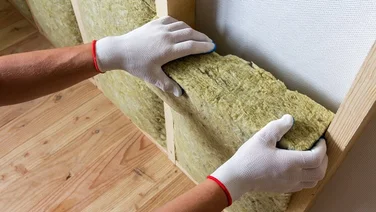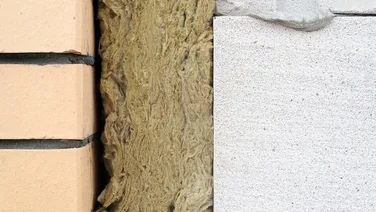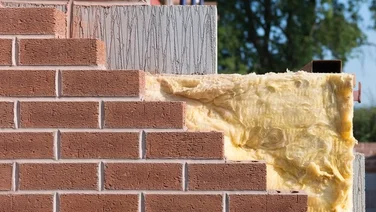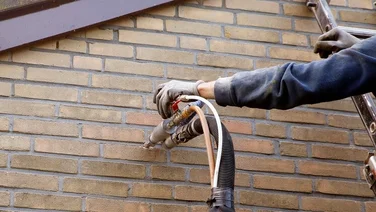- Suspended floors have spaces beneath the floor to prevent damp
- However, suspended floors can be draughty and are not energy efficient
- Several different materials can be used to insulate suspended floors
Many older properties in the UK have suspended floors either made of concrete or, more commonly, of timber, consisting of wooden joists with floorboards laid on top.
This leaves a gap beneath the floor, which is great for preventing the buildup of moisture and damp, but these floors can also be draughty and poorly insulated. In fact, only 3% of the UK’s suspended floors are insulated.
Here, we explain what types of insulation are available for suspended flooring and how much it costs to install it.
Get free insulation quotes
Answer a few quick questions, and our trusted installers will send you bespoke insulation quotes – for free.

What is a suspended floor?
There are generally two types of floor structure: solid and suspended. Suspended floors are mostly features of older houses and there are approximately 8-10 million UK homes with this type of floor. They can be made either of timber or of concrete.
In the case of timber suspended floors, wooden floorboards are attached to joists. With both concrete and timber suspended floors, the floor is situated just above the building’s foundations. This creates a small gap beneath the floor that enables ventilation and air movement, thereby preventing damp from creeping into the structure. This is especially beneficial to buildings located in poorly drained areas.
However, there are some disadvantages in the case of a timber suspended floor. One of them is that the timber can rot over time, which means it needs more maintenance than other types of floor. Secondly, timber suspended floors are also not able to carry as much weight as a concrete floor. Finally, timber suspended floors can be draughty, so they need proper insulation.
Is it worth insulating a suspended floor?
The Energy Saving Trust estimates that up to £75 per year can be saved off your energy bills from floor insulation in general, alongside reductions in carbon emissions. In terms of total energy saved, insulating a suspended floor area of 150 square metres with quilted mineral wool insulation can save around 1,500 kWh of energy per year. This works out at around £100 per year saved from your energy bills.
How much does suspended floor insulation cost?
Material | 10 square metres | 15 square metres | 20 square meters |
|---|---|---|---|
Mineral wool rolls | £190-£250 | £210-£275 | £380-£500 |
Mineral wool slabs | £210-£280 | £240-£320 | £420-£560 |
Sheep wool | £330-£450 | £420-£575 | £660-£900 |
Spray insulation | £350-£700 | £450-£950 | £700-£1,400 |
Loose insulation | £210-£280 | £240-£320 | £420-£560 |
The cost of floor insulation in general really depends on the scale of the work involved. When installed using a professional service, floor insulation can cost anywhere between £190 and £1,400, depending on the materials used and the floor area to be insulated.
PIR/PUR boards (Polyisocyanurate/Polyurethane) are popular rigid insulation boards and are generally available in sheets measuring 1.2 metres by 2.4 metres, but they can be cut to size. The average cost for these boards is £20-£60 per sheet.
Mineral wool rolls covering approximately six square metres cost, on average, around £25-£30 per roll.
Sheep wool costs around £18-£25 per square metre.
Loose fill insulation costs around £1.50 per kilogram.
Get free spray foam insulation quotes
Answer a few quick questions, and our trusted installers will send you bespoke spray foam insulation quotes – for free.

What factors affect the cost of suspended floor insulation?
There are a number of factors that affect the cost of installing suspended floor insulation. One of the more obvious is the size of the room, as it follows that the larger the room, the more insulation material will be required. Another factor is the type of insulating material you choose to insulate the floor.
A third factor, perhaps the main one, is how much work is involved. If you need to take up the floorboards, this will add to the cost, as will any work needed to move radiators, renew skirting boards and adjust door opening heights.
How long does suspended floor insulation take to install?
There are two main approaches to insulating suspended floors. Either you can apply insulating material on top of the floor, or you can take up the floorboards and insulate the floor from below. If you opt for the first approach, insulating from above, the insulating material must be thin, in order to avoid impacting the door opening height. This is usually undertaken with a floor lining material such as Sempafloor, or wood fibre, warmup or foam insulation boards.
The second option is the most work-intensive, as it involves taking up the floorboards, but it is the more effective of the two approaches as it provides a real opportunity to effectively insulate and draught-proof the floor. However, another approach is to insulate from beneath the floorboards without taking up the boards themselves. This is carried out using a method called Q-Bot in which robots spray expanding foam insulation under the floor.
Installing suspended floor insulation can take anywhere between a few hours to 2-3 days, depending on the size of the floor area being insulated and the materials used. Simply installing spray foam may take just 2-4 hours, but taking up the floorboards and installing other materials may take much longer.
Can you do the suspended floor insulation yourself?
Yes, many people install floor insulation material themselves, but this requires experience and proper equipment as well as appropriate health and safety measures. If you choose to install the material yourself, it is wise to be aware of the various intricate details involved in the process of installation and to carry out these tasks carefully. You also need to comply with the relevant building regulations for your type of property.
The best types of suspended floor insulation
The best types of suspended floor insulation include mineral wool insulation, foil faced boarding, and expanding foam.
We’ll go into more detail about each in the following sections.
Mineral wool insulation
Mineral wool is often preferred over rigid board insulation because it can be easily packed in between the floor joists and supported in situ by chicken wire or netting. This approach eliminates heat loss through the gaps in the joists, but it can also cause ‘wind-washing’. This is when cold air moves from the gap beneath the floor through the fibres, reducing this material’s thermal advantages. The wind-washing problem can be solved by wrapping the material in a membrane, which also helps to further reduce damp, condensation and mould.
Foil faced boarding
A common material used in suspended floor upgrades is foil-faced PIR/PUR (Polyisocyanurate or Polyurethane) boards. These can provide some short-term thermal benefits but are not ideal as they are inflexible and also gradually absorb and disperse water vapour.
Expanding foam
Expanding foam has the advantage of helping to seal gaps in the insulation coverage caused by warped joists that do not easily match themselves to conventional board insulation. This is especially true in those older properties that are of heritage value, where the construction of the floor structure dates from particular historical periods. However, this approach tends to lack flexibility and the material also does not breathe, thereby trapping any moisture that enters the building beneath the floor over time and preventing the space from drying out naturally.
Summary
Insulating suspended floors can be complicated or relatively simple, depending on the condition of the floor and the amount of floor space to be insulated, as well as the insulating materials chosen to achieve this. This level of complexity, or not, also affects the cost.
You can carry out this task yourself (if you have the experience and the equipment) in order to save costs, but for more complicated projects it is probably better to consult a professional installer.
FAQs
What is the best insulation for suspended floors?
By far the best insulation material for suspended floors is fibrous material in rolls, such as sheep’s wool or mineral wool, as it takes up space between the joists, filling any gaps. In older homes, where timbers have moved or warped, it may have to be wrapped in a membrane to prevent wind-washing.
Should you insulate a suspended floor?
Insulating a suspended floor is a great idea in order to increase the overall energy efficiency of the building, as suspended floors can be draughty. By far the best way to insulate a suspended floor is with fibrous material in rolls. However, you will probably have to take up all the floor boards first in order to achieve this.
Can you insulate a suspended ground floor?
Yes, you can insulate a suspended ground floor, and it is advisable to do so in order to improve your home’s energy efficiency, as a suspended ground floor is a major cause of heat loss within an older property.






